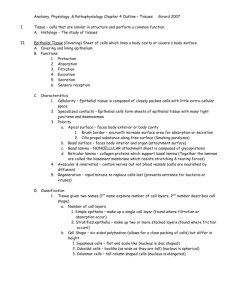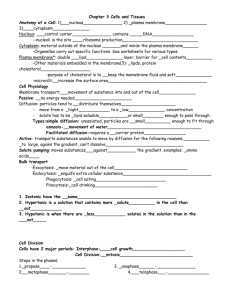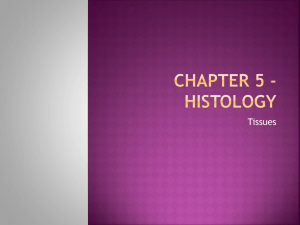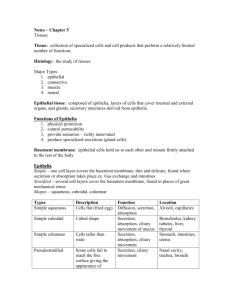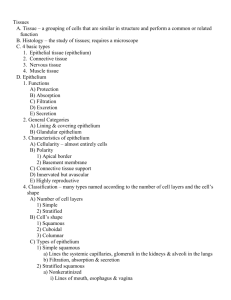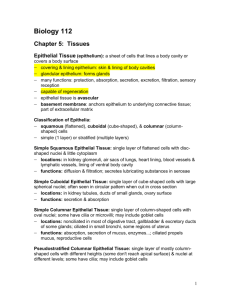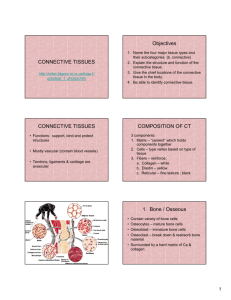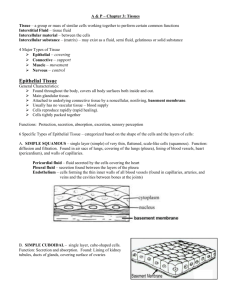Anatomy & Physiology: Tissue Types & Functions
advertisement
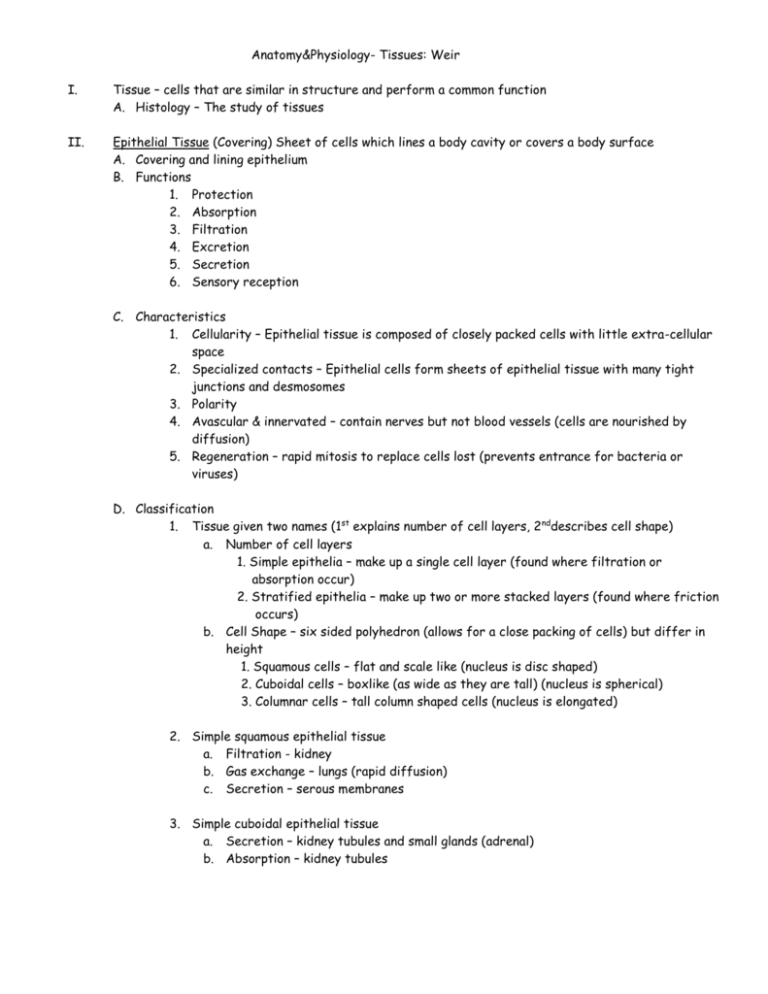
Anatomy&Physiology- Tissues: Weir I. Tissue – cells that are similar in structure and perform a common function A. Histology – The study of tissues II. Epithelial Tissue (Covering) Sheet of cells which lines a body cavity or covers a body surface A. Covering and lining epithelium B. Functions 1. Protection 2. Absorption 3. Filtration 4. Excretion 5. Secretion 6. Sensory reception C. Characteristics 1. Cellularity – Epithelial tissue is composed of closely packed cells with little extra-cellular space 2. Specialized contacts – Epithelial cells form sheets of epithelial tissue with many tight junctions and desmosomes 3. Polarity 4. Avascular & innervated – contain nerves but not blood vessels (cells are nourished by diffusion) 5. Regeneration – rapid mitosis to replace cells lost (prevents entrance for bacteria or viruses) D. Classification 1. Tissue given two names (1st explains number of cell layers, 2nddescribes cell shape) a. Number of cell layers 1. Simple epithelia – make up a single cell layer (found where filtration or absorption occur) 2. Stratified epithelia – make up two or more stacked layers (found where friction occurs) b. Cell Shape – six sided polyhedron (allows for a close packing of cells) but differ in height 1. Squamous cells – flat and scale like (nucleus is disc shaped) 2. Cuboidal cells – boxlike (as wide as they are tall) (nucleus is spherical) 3. Columnar cells – tall column shaped cells (nucleus is elongated) 2. Simple squamous epithelial tissue a. Filtration - kidney b. Gas exchange – lungs (rapid diffusion) c. Secretion – serous membranes 3. Simple cuboidal epithelial tissue a. Secretion – kidney tubules and small glands (adrenal) b. Absorption – kidney tubules 4. Simple columnar epithelial tissue a. Absorption –stomach to rectum of digestive tract b. Secretion of mucus (goblet cells) or enzymes c. Ciliated type propels mucus or reproductive cells in uterus 5. Pseudostratified columnar epithelial tissue a. Secretion of mucus (goblet cells) b. Propulsion of mucus (ciliary action) Pseudostratified ciliated columnar epithelium in the respiratory bronchi and trachea 6. Stratified squamous epithelial tissue (Regenerate from basal layer as apical layer is removed) a. Protects underlying tissue in areas subject to abrasion b. Moist linings – mouth, esophagus, vagina (akeratinized) 7. Stratified columnar epithelial tissue (Regenerate from basal layer as apical layer is removed) a. Protection – male urethra b. Secretion – large glands e.g. pancreas 8. Transitional epithelial tissue a. Stretching – forms lining of urinary organs E. Glandular epithelia 1. Gland – one or more cells which make and secrete an aqueous or lipid fluid 2. Endocrine (ductless) glands – internally secreting into the extra cellular space 3. Exocrine glands – externally secreting through ducts either out of the body by exocytosis (e.g. mucus, sweat, oil, apocrine, & salivary) or into the G.I. tract (e.g. liver, pancreas) 4. Unicellular exocrine gland – goblet cells which produce mucin, a glycoprotein, which dissolves in water to form mucus III. Connective Tissue (Support) A. Extracellular matrix – nonliving matrix separates the living cells of the tissue allowing the tissue to bear weight and tension forces B. Collagen fibers – constructed of a white protein collagen, these fibers are for withstanding tensile forces and are stronger than steel fibers of the same diameter. C. Elastic fibers – constructed of the yellow protein elastin, these fibers have the ability to stretch and recoil like rubber bands D. Reticular fibers – Branched networks of collagen fibers that support blood vessels and organs E. Tissue types (connective) 1. Areolar connective tissue a. Support and bind other fibers b. Hold body fluids (edema is a build up of fluid in the extracellular matrix) c. Defend against infection (Mast cells and macrophages reside in the extracellular space 2. Adipose Tissue – Fat a. Storage of fat b. Rich vascular system c. Shocker absorber d. Insulator 3. Reticular connective tissue a. Constructed of ONLY reticular fibers b. Provides framework for blood cells in lymph nodes, the spleen, and bone marrow 4. Fibrous connective tissue (Dense regular connective tissue) a. Bundles of collagen fibers with fibroblasts crowded between fibers forming tendons and ligaments b. Used for tensile strength 5. Dense irregular connective tissue a. Bundles of collagen fibers which tend to be thicker and run in more than one plane to support tension from different directions b. The dermis is made of dense irregular connective tissue which gives it a durable leathery protective barrier 6. Cartilage a. Withstand tension and compression b. Three types of cartilage 1. Hyaline cartilage – found on the ends of long bones, attach ribs to sternum, forms respiratory passages, and the tip of the nose 2. Elastic cartilage – Forms external ear (contains more elastin fibers) 3. Fibrocartilage – Forms intervertebral discs and the spongy cartilage of the knee (Can withstand compressive forces) 7. Bone a. Osseous tissue is rigid due to calcium salts added to the matrix b. Support and protect the body, store fat and calcium salts, synthesize blood cells c. Osteoblasts are bone cells which construct new bone; osteoclasts are bone cells which break bone down 8. Blood a. fluid matrix is called plasma b. fibers of blood only visible during blood clotting c. Transport respiratory gasses, nutrients, wastes, and other substances IV. Muscle Tissue (Movement) A. Skeletal muscle - striated B. Cardiac muscle – striated and has intercalated discs C. Smooth muscle – lack striations V. Nervous Tissue (Control) A. Neurons are the functional cells B. Function is to communicate electrical messages throughout the body
